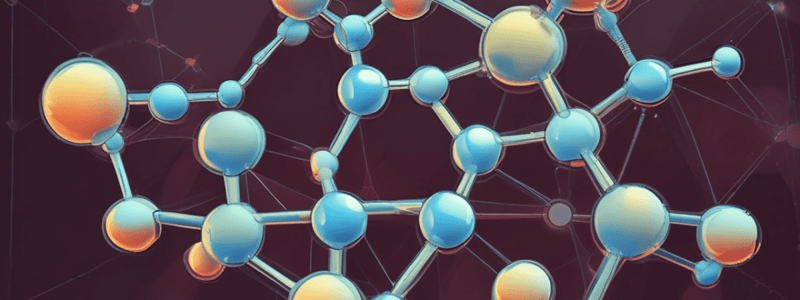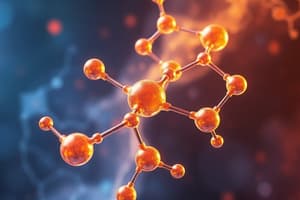Podcast
Questions and Answers
What is the molecular formula of thiophene?
What is the molecular formula of thiophene?
- C4H5S
- C4H4S (correct)
- C4H3S
- C4H6S
What is the boiling point of thiophene?
What is the boiling point of thiophene?
- 90°C
- 80°C
- 100°C
- 84°C (correct)
Why is thiophene separated from benzene?
Why is thiophene separated from benzene?
- Due to its low boiling point
- Due to its high reactivity towards sulfonation (correct)
- Due to its low reactivity towards sulfonation
- Due to its high solubility in water
What is the hybridization of the atoms in the thiophene ring?
What is the hybridization of the atoms in the thiophene ring?
What is the number of non-bonding electrons in the thiophene ring?
What is the number of non-bonding electrons in the thiophene ring?
Why is thiophene aromatic?
Why is thiophene aromatic?
What is the solubility of thiophene in water?
What is the solubility of thiophene in water?
What is the reason for the difference in aromaticity between thiophene and furan?
What is the reason for the difference in aromaticity between thiophene and furan?
What is the electron donating tendency of sulphur compared to nitrogen and oxygen?
What is the electron donating tendency of sulphur compared to nitrogen and oxygen?
What is the product of the condensation reaction between a 1,2-dicarbonyl compound and diethyl thiodiacetate in the presence of a strong base?
What is the product of the condensation reaction between a 1,2-dicarbonyl compound and diethyl thiodiacetate in the presence of a strong base?
What is the temperature required for the synthesis of thiophene from n-butane?
What is the temperature required for the synthesis of thiophene from n-butane?
In electrophilic substitution reactions, where does the new substituent usually enter on thiophene?
In electrophilic substitution reactions, where does the new substituent usually enter on thiophene?
What is the reactant used in the Paal-Knorr synthesis of thiophene?
What is the reactant used in the Paal-Knorr synthesis of thiophene?
Why does the new substituent prefer to enter on the 2-position in electrophilic substitution reactions of thiophene?
Why does the new substituent prefer to enter on the 2-position in electrophilic substitution reactions of thiophene?
What is the catalyst used in the synthesis of thiophene from acetylene?
What is the catalyst used in the synthesis of thiophene from acetylene?
What is the reactant used in the laboratory synthesis of thiophene from sod. succinate?
What is the reactant used in the laboratory synthesis of thiophene from sod. succinate?
What is the result of treating thiophene with hot phosphoric acid?
What is the result of treating thiophene with hot phosphoric acid?
What is the reason for the greater aromaticity of thiophene compared to furan?
What is the reason for the greater aromaticity of thiophene compared to furan?
What is the limitation of reducing thiophene using Raney Ni?
What is the limitation of reducing thiophene using Raney Ni?
What is the result of partial reduction of thiophene in acidic media?
What is the result of partial reduction of thiophene in acidic media?
Which reaction does not occur with thiophene?
Which reaction does not occur with thiophene?
What happens to thiophene when it undergoes oxidation?
What happens to thiophene when it undergoes oxidation?
Which of the following groups makes monosubstituted furan and thiophene less reactive?
Which of the following groups makes monosubstituted furan and thiophene less reactive?
What is the medical use of Sitaxsentan?
What is the medical use of Sitaxsentan?
What is the characteristic of Cephalothin?
What is the characteristic of Cephalothin?
What is the reaction that does not occur with thiophene?
What is the reaction that does not occur with thiophene?
What is the medical use of Tiagabine?
What is the medical use of Tiagabine?
Which of the following groups makes monosubstituted furan and thiophene more reactive?
Which of the following groups makes monosubstituted furan and thiophene more reactive?
What is the condition that Sitaxsentan is used to treat?
What is the condition that Sitaxsentan is used to treat?
What is the characteristic of Thiophene electrophilic substitution?
What is the characteristic of Thiophene electrophilic substitution?
What is a characteristic of monosubstituted furan and thiophene with electron withdrawing groups?
What is a characteristic of monosubstituted furan and thiophene with electron withdrawing groups?
Which of the following is NOT a medical use of a heterocyclic compound?
Which of the following is NOT a medical use of a heterocyclic compound?
What is the effect of oxidation on tetrahydrothiophene?
What is the effect of oxidation on tetrahydrothiophene?
What is the structural relationship between Cephalothin and other antibacterial agents?
What is the structural relationship between Cephalothin and other antibacterial agents?
Which of the following groups makes monosubstituted furan and thiophene more reactive?
Which of the following groups makes monosubstituted furan and thiophene more reactive?
What is the medical condition that Sitaxsentan is used to treat?
What is the medical condition that Sitaxsentan is used to treat?
What is the effect of partial reduction on thiophene in acidic medium?
What is the effect of partial reduction on thiophene in acidic medium?
What is the characteristic of electrophilic substitution reactions in monosubstituted furan and thiophene?
What is the characteristic of electrophilic substitution reactions in monosubstituted furan and thiophene?
What is the similarity between the medical uses of Sitaxsentan and Tiagabine?
What is the similarity between the medical uses of Sitaxsentan and Tiagabine?
What is the effect of oxidation on thiophene?
What is the effect of oxidation on thiophene?
Flashcards are hidden until you start studying
Study Notes
Thiophene
- Thiophene is a heterocyclic compound with the formula C4H4S, consisting of a flat five-membered ring.
- It is aromatic, as indicated by its extensive substitution reactions.
Properties of Thiophene
- At room temperature, thiophene is a colorless liquid with a mildly pleasant odor reminiscent of benzene.
- Its boiling point is 84°C.
- It is insoluble in water but freely soluble in ethanol, ether, and acetone.
- The high reactivity of thiophene towards sulfonation is the basis for the separation of thiophene from benzene.
Thiophene Aromaticity
- Thiophene has 4C and 1S, all of which are sp2 hybridized.
- sp² hybridization is planar, making a planar thiophene ring structure.
- Each ring atom also contains an unhybridized p orbital that is perpendicular to the plane of σ bonds (plane of ring).
- The total number of non-bonding electrons is 6 (4 from four C, 2 from one S).
- The resonance of 6 electrons follows the Hückel's rule.
- Thiophene is more aromatic than furan due to the less electronegative sulfur atom, which has a greater electron donating tendency.
- The donated electrons take part in delocalization in the ring.
Synthesis of Thiophene
- Commercial method: By reaction of sulphur with n-butane in the gas phase at 650 °C.
- From Acetylene: By passing a mixture of acetylene and hydrogen sulphide through a tube containing aluminium oxide at 600°C.
- Paal-Knorr synthesis: The condensation of 1,4-dicarbonyl compounds with sulfur sources gives thiophene.
- From sod.Succinate: Laboratory synthesis by heating a mix of sod.succinate and phosphorus trisulfide.
- Hinsberg Synthesis: Condensation between a 1,2-dicarbonyl compound and diethyl thiodiacetate in the presence of a strong base gives thiophene 2,5- diacids (-diketone).
Reactions of Thiophene
- Electrophilic substitution: Thiophene is more easily substituted than benzene but less vigorously than furan and pyrrole.
- The new substituent usually enters on the 2-position. If the 2-positions are occupied, then on the 3-position.
- Thiophene undergoes electrophilic substitution reaction at 2nd position due to two reasons: C2 attack gives more resonance contributing structures than C3, and an extra stable contributing structure generates upon C2 attack.
- Very strongly acidic conditions lead to acid-catalyzed polymerization.
- The action of hot phosphoric acid on thiophene leads to a trimer.
- Friedel-crafts acylation and Chloromethylation reactions are possible.
- Reaction with organolithium or 2- lithiumthiophene is also possible.
- Reduction: Partial reduction in acidic media, but thiophene cannot be reduced under the same conditions as in furan due to sulfur poisoning the catalyst and desulphurization occurs with ring opening.
Medical uses of Thiophene
- Sitaxsentan: Cardiovascular Agent, used in pulmonary artery hypertension.
- Tiagabine: Anticonvulsant Agent, used in the treatment of epilepsy.
- Cephalothin: New semisynthetic antibacterial agent structurally related to Pencillins, effective against penicillinase-producing staphylococci as well as other gram-positive and gram-negative organisms.
Studying That Suits You
Use AI to generate personalized quizzes and flashcards to suit your learning preferences.




